TTeam & TTouch philosophy:
To respect each animal as an individual.
To honor the role of animals as our teachers.
To bring awareness to the importance of animals in our lives.
To recognize the individual learning process of every human and animal.
To encourage harmony, cooperation and trust between humans and animals as well as amongst humans.
That most resistance comes from tension, discomfort or pain in the horses body or lack of balance (physical, mental and emotional).
Increases attention, obedience, self-control, self-confidence, coordination, balance, and focus
Enables greater range of motion (especially useful in older equines)
Corrects behavioral problems
Reduces tension; fear; and pain (resulting from illness and/or competitive stress)
Helps Cope with episodes of stress, injury and colic
Improves performance and condition
Aids horses in understanding of training sessions
Corrects specific riding tendencies (dropping inside shoulder, stumbling, short striding, etc.)

The body wrap.
Some of the Tools
Wand (Dressage whip) - A 4' dressage whip with 3" tassel. This is called a 'wand' because of the way it is used. It also keeps you aware of the difference between a communication tool and a whip. The wand is used to guide the horse through ground and riding exercises, as an initial contact medium between horse and human and as a cue re-enforcer.
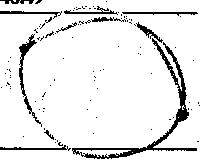
Rope neck ring - A riding aid for bridleless riding. The neck ring provides guidance to the horse.
Balance rein - A riding aid. The balance rein helps the horse rebalance during riding exercises by influencing the neck and head carriage.
Promise Rope - A small diameter rope, attached to the saddle and running loosely behind the hindquarters, above the hocks. It is used to 'promise' forward movement.
Driving lines - Long lines used to educate the young horse or re-educate an older horse to riding cues. Initially used as a single set tied around chest to withers and in conjunction with a second person leading. This allows the transfer of cues from the lead (on the halter) to the lines. A second set of lines can be added, attached to the halter or headstall / bit to facilitate learning bit cues.
Lindell - The lindell is a rope noseband headstall used in starting young horses. Many horses go quite well in the lindell and never require bitting.
Body wraps (Ace bandage or rope) - The wraps are placed on the horse in a figure eight pattern, around the neck and hindquarters, crossing just behind the withers. The body wrap is effective in working with horses that do not collect well, that have emotional stress or that have gait difficulties.
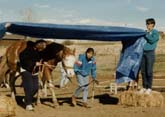
Leading under the tarp--preparation for trailer loading.
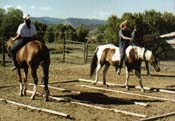
Riding thru the labyrinth.
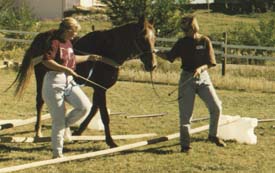
Leading thru the uneven poles.

Linda Bertani riding a horse with a body wrap.

TTEAM Clinic at Raian's place.
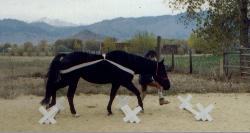
Leading the horse with the body wrap over elevated poles.

Use of the balance rein--notice the difference in the horse's frame.
Photos courtesy of
Raian Kaiser of 7 Acres Horse Training
TTEAM
TTEAM
The following is a recap of the article on facial swirls:
The Facial Swirls article in June 1995 Western Horseman talks about analysing
your horse's personality by his facial swirls. It is an excerpt from a Linda
Tellington Jones book. Jones talks about the swirls on horses being like our
fingerprints-no two just alike and certain breed association use them as
identification marks. She has studied facial swirls since 1965 and has found
the evaluations to hold true 70% of the time. She says you have to look at
other things such as ears, eyes, mouth-not just swirls. Sometimes other
characteristics will out weigh the swirl. The article explains several types of
swirls and their meanings:
(taken from article)
1. Single swirl between or above the eye is the standard on diplayed by the
majority of horses in her studies. Indicates horse with generally uncompicated
nature, but ther are variations. Swirls may be set to one side or the other.
Swirls set to the left as you face the animal-horse will tend to be a touch more
complicated but still trustworthy. Set to right may be less cooperative than
those with center or let to left swirl. In general, swirls of this sort are
less indicative of characher that the more complex patterns.
2. Single swirl several inches below the eyes-she found 80-% of horses with
this are unusually imaginative and intelligent; like to amuse themselves-turn on
water, open stall doors, untying complicated knots, find ways to escape
pastures. These horses are usually of above average intelligence and are
interesting characters to deal with.
3. A single long swirl that may be between the eyes or extend below: Indicates
a horse who is friendly and particularly enjoys relating to people.
4. Two swirls adjoining, either one above the other or side by side: These can
be above, between, or below the eyes and are sometimes set at an angle to each
other. Horses with this tend to be more emotional and over-reactive than
average. Tend to become upest without apparent reason, and at unexpected
moments. When such horses blow up, the best way to handle them is to back off
and allow them to settle. Punishing them doesn't help; in fact it usually only
aggravates the behavior more and can even bring on more resistance. However,
she says a horse like this can be a great horse-she has had some of her best
show horses with this configuration but generally, horses with this pattern are
not ideal for inexperience riders.
5. Three swirls close together on the forehead (not up under the forelock)
Rare; In gelding and mares this indicates a complex individual but not an
unpredictable one, stallions, however, are another story--about 80% of the
stallions Jones has observed having this marking have exhibited unreliable,
often dangerous behavior.
Jones says the best way to use facial swirls in analyzing personality is to
evaluate them in conjuction with all other characteristics of the horse's head.
The book this article is from is "Getting in Touch: Understand and Influence
Your Horse's Personality".
My day of TTeam was full of so much information my mind is swimming .... and
I am now a convert ... so where do I start ...
Well Catherine Hamber was great .. she was so clear with all her
instructions ... I am happy with how I do my circles and python lifts - they
were the main things we did....
Then we did pole work and walked the horses through the labyrinth and star
poles ... now I am an action person and thought I was going to be bored with
this ... but ahhhhhhhhhhhhh you could see how the TTeam philosophy came in
... The idea of just making the horse aware of its preferred patterns and
then becoming aware of a new way of doing things (thats my interpretation so
hopefully I am on the right track) ..
Then we had fun with the wand ... I had to try and convince a nervous
2 yo mini how to follow the wand .. he just clung to my side ... so I will
have to work on that one ...
My favourite ... is the wrap .... having had it discussed to pieces
on the list... I had some weird perception, especially when all I had seen
was the t-shirt adaptation for dogs .. and my mind could not get it
happening for a horse ... but what an effective tool .. and I could think of
20 clients off the top of my head who could employ it yesterday even...
We did little belly lifts and then connected the tummy to the back
with cow licks .. that is such a smooth sweep ... and then we learned a way to
tie a horse who was resisting standing still for the movement ..
ummmmmmmmmmm I'll come back when I remember the name .. oh yes - taming the
tiger ...
,br>
We did a nice assessment routine ... and upon my request we did some
ear work .. thank goodness the teacher was flexible .. so now I know the
point in the ears for shock when Red next goes into shock ... now I know it
hopefully it means he will never do it again ...
We played with tails .. we did racoons down the inside of the leg and
across the tail .. we lifted the tail but the hair and did rotations .. and
we did an interesting one .. which I forget the name for if it had a name ..
you held under the top of the tail and the base of the dock and just lifted
the base up so the tail curved and held the tension in it .. oh and we did a
few tail stretches and one movement where you leaned into the back of each
thigh and pushed in ...
Then we did feet rotations .. picking up the feet, learning how to do
it so the horse set itself balanced before you left it to 3 legs .. and
rotated them nicely to free up the hip etc ... and then putting it down on
the toe so its was not doing its usual habitiual behaviour ..
phew .. I think that was it .. oh we also looked at using these wonderful
soft rubber brushes and lambswool mits ..
But apart from that you know how hard I am to impress .. even to make a
suggestion to me sometimes puts te fear into some of you .. well I came
away overloaded with information and it will take time for it to assimilate
.. I can see how I could intergrate TTeam with my own work and on some
occasions how I could use it on its own ..
I loved the way it dealt with posture and assessing and using simple things
to break bad habits and help the horse become aware of its movements ...
and its simplicity makes it really a nice way for an owner to work with
their horse safely ... you dont have to be a full-time therapist like me ...